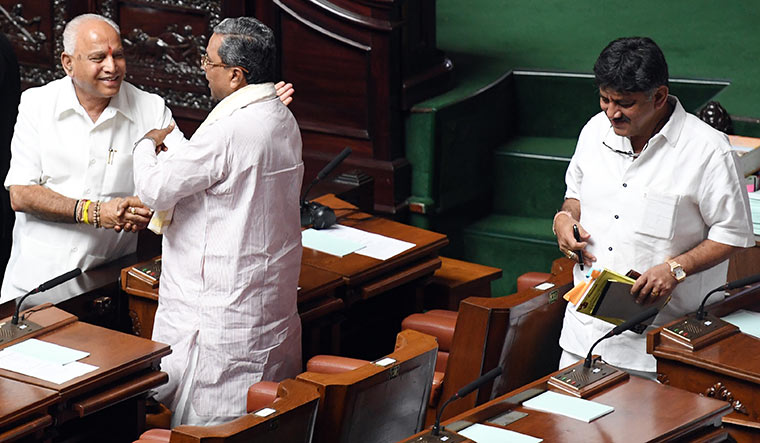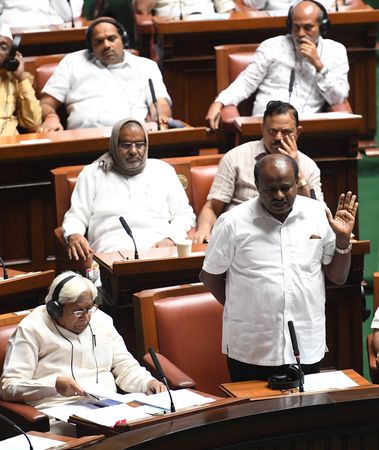As fractured mandates have made coalitions inevitable, “rebels” have held sway over Karnataka politics for more than a decade. Charges of horse trading, disqualifications, trust votes, collapse of governments, a spate of byelections—the cycle has continued.
This time, the rebellion brought down the 14-month-old Congress-Janata Dal (Secular) coalition government. The 224-member Karnataka assembly was trimmed to 207, with the speaker disqualifying 17 “rebel” MLAs under the Tenth Schedule of the Constitution (anti-defection law). B.S. Yediyurappa was sworn in as chief minister for the fourth time, and he cleared the floor test.
While the resignations of the Congress rebels from north Karnataka was not a surprise (the BJP was known to be wooing leaders from the Lingayat belt), what rattled the allies was the resignation of three JD(S) MLAs and the Bengaluru legislators who are known to be loyal to former chief minister Siddaramaiah.
The speaker’s decision has sparked a debate on the 1985 anti-defection law. It has been accused of muzzling dissent and promoting party loyalty at the expense of the democratic spirit.
Interestingly, the rebels this time belong to different camps, including the wealthy and the loyalists, which hints that the lure to resign was not money or the promise of a position in the new government. While party-hopping was never considered a sin, the mass resignations smack of a larger political game. Though the Congress rebels have charged the JD(S) with nepotism, the initial reasons for the discord were the alleged interference of the JD(S) leaders and the neglect of their constituencies.
Moreover, the results of the Lok Sabha elections, where the BJP won 25 of 28 seats, was an eye-opener for the allies. And with the humiliating defeats of veterans such as H.D. Deve Gowda, Mallikarjun Kharge, Veerappa Moily and K.H. Muniyappa, both parties had axes to grind.
The show of camaraderie during the 2019 Lok Sabha elections was not enough to overcome the decades-old rivalry between the JD(S) and Congress, as both survive on the common Ahinda vote base. The alliance, which was “imposed” by the Congress high command in a bid to woo allies ahead of the Lok Sabha elections, seems to have backfired on the party. It created wider rifts in the divided house.
Siddaramaiah felt threatened by Vokkaliga strongman and Congress troubleshooter D.K. Shivakumar cosying up to the JD(S) and former chief minister H.D. Kumaraswamy. He also seemed rankled by the prospect of having to pull through a coalition which, according to many in the Congress, was weakening the party.
That the Congress continues to face a leadership crisis is perhaps the biggest worry. Siddaramaiah is now the fall guy as the resignation of his close confidants shocked even the party’s central leaders.
Many in the party suspect Siddaramaiah’s hand in the political coup. JD(S) rebel A.H. Vishwanath blamed him for the lack of coordination among the allies, and the Congress’s Muslim face, Roshan Baig, too, alleged that the state leadership was responsible for the Lok Sabha debacle. Siddaramaiah, however, dared critics to prove the charges and had strongly advocated for the rebels’ disqualification. “It will be a befitting lesson for backstabbers,” he had said.
The Congress not having a national leader has also done its bit in breeding anarchy. The state unit was recently dismantled and showed no urgency to constitute a new one. At a time when the state unit was fighting its own battles within the party, the imposition of an alliance with the JD(S) had disillusioned both the leaders and cadres alike.
Meanwhile, the saffron surge in the country encouraged the rebels to jump ship. The BJP has enhanced its vote share in the state to 51 per cent, and had led in as many as 170 assembly segments.
Of the 17 rebels, the eight from the Lingayat heartland stand to gain as the region is a BJP bastion. The legislators who won by wafer-thin margins in the assembly elections (there were a few in the Congress) had a reason to leave their party for the BJP, which had won the Lok Sabha polls handsomely.
As for the nine rebels from south Karnataka, including the Bengaluru legislators, a future with the BJP seems promising. The BJP does not have a strong presence in the Old Mysore region and enough Vokkaliga and backward class leaders to take on the Congress and the JD(S). For instance, Vokkaliga leaders Dr K. Sudhakar (Chikkaballapur) and S.T. Somashekar (Yeshwantpur) have enough space in the BJP. Similarly, Kuruba leaders like R. Shankar, Byrathi Basavaraj and M.T.B. Nagaraj, all wealthy, can get a strong foothold in the BJP.
For all that to happen, however, everyone will have to wait for at least six months. If the Supreme Court upholds the speaker’s ruling, the rebels will be unable to contest byelections till the end of the term of this assembly—May 2023. However, if the apex court rules that the disqualification only bars the legislators from holding any office of profit until they are re-elected, the rebels can be inducted after they win the byelections. All the Congress and JD(S) rebels have been expelled from their parties.
The rebels have moved the Supreme Court, wanting their disqualification orders to be quashed. They also have the herculean task of taking their electorate into confidence.
For now, though, Yediyurappa will form the cabinet without having to worry about accommodating the rebel legislators. And this is good news for the BJP loyalists who saw the possible induction of the rebels as a threat to their seniority and positions within the party. Some senior leaders were also against inducting people who did not follow the BJP ideology as there would be a constant risk of them jumping ship or demeaning the party.
The Congress and the JD(S), meanwhile, are mum over the fate of the alliance. In the Congress, factionalism, ego clashes and oneupmanship have resulted in chaos, pushing it towards a leadership crisis. The central leaders are trying to broker peace and correct the power imbalance by appointing the leader of the opposition and a new party president to prepare for the byelections. Insiders say that Siddaramaiah, the Ahinda leader, is still considered the vote-puller, while Shivakumar, the organisational man, can lead the party in war time.
The JD(S), on the other hand, has already started the hunt for “winning” candidates. Party patriarch Deve Gowda has given the clarion call to party workers to unite and energise the party. As Kumaraswamy puts it, for a regional party out of power, every day is a battle for survival. The party is planning a statewide padyatra to reach out to its workers, supporters and voters.
Weeks of political turmoil seems to have abated. Yet, in the political parties, a lot continues to simmer.



